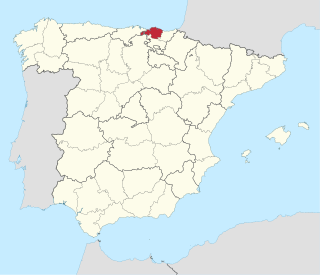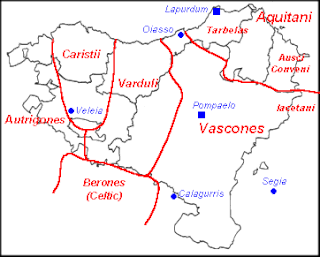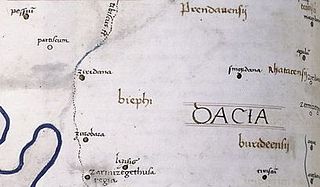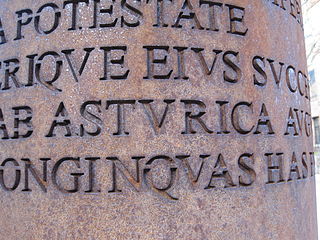Related Research Articles

Astorga is a municipality and city of Spain located in the central area of the province of León, in the autonomous community of Castilla y León, 43 kilometres (27 mi) southwest of the provincial capital. It is located in the transit between the Páramo Leonés and the mountains of León and acts as the backbone of the comarcas of Maragatería, La Cepeda and the Ribera del Órbigo. The city is the head of one of the most extensive and oldest dioceses of Spain, whose jurisdiction covers half of the province of León and part of Ourense and Zamora. It is also head of the judicial party number 5 of the province of León.

Salamis was an ancient Greek city-state on the east coast of Cyprus, at the mouth of the river Pedieos, 6 km north of modern Famagusta. According to tradition, the founder of Salamis was Teucer, son of Telamon, king of the Greek island of Salamis, who could not return home after the Trojan War because he had failed to avenge his brother Ajax.

Biscay is a province of Spain and a historical territory of the Vascongadas, heir of the ancient Lordship of Biscay, lying on the south shore of the eponymous bay. The capital and largest city is Bilbao.

MOLA is an archaeology and built heritage practice and independent charitable company registered with the Chartered Institute for Archaeologists (CIfA), providing a wide range of professional archaeological services to clients in London and across the country. It is one of the largest archaeological service providers in the UK, and is the only one with IRO status.

The Brigantes were Ancient Britons who in pre-Roman times controlled the largest section of what would become Northern England. Their territory, often referred to as Brigantia, was centred in what was later known as Yorkshire. The Greek geographer Ptolemy named the Brigantes as a people in Ireland also, where they could be found around what is now Wexford, Kilkenny and Waterford, while another people named Brigantii is mentioned by Strabo as a sub-tribe of the Vindelici in the region of the Alps.

Heshbon were at least two different ancient towns located east of the Jordan River in what is now the Kingdom of Jordan, historically within the territories of ancient Ammon.

Patara was an ancient and flourishing maritime and commercial city that was for a period the capital of Lycia. The site is located on the Turkish coast near to the village of Gelemiş, in Antalya Province.

Pella was an ancient city in what is now northwest Jordan, and contains ruins from the Neolithic, Chalcolithic, Bronze Age, Iron Age, Canaanite, Hellenistic and Islamic periods. It is located near a rich water source within the eastern foothills of the Jordan Valley, close to the modern village of Ṭabaqat Faḥl some 27 km (17 mi) south of the Sea of Galilee. The site is situated 130 km (81 mi) north of Amman: a drive of about two hours, and an hour southwest by car from Irbid, in the north of the country. Pella's ruins – predominantly temples, churches, and housing – have been partially excavated by teams of archaeologists; they attract thousands of tourists annually but especially in spring, during which time the area is awash with spring flowers.

Santa Pola is a coastal town located in the comarca of Baix Vinalopó in the Valencian Community, Spain, by the Mediterranean Sea. It has an area of 58.6 km2 (23 sq mi) and has a population of 36,174 inhabitants of whom 6,000 are residents of the nearby town of Gran Alacant.
The Novantae were a people of the late 2nd century who lived in what is now Galloway and Carrick, in southwesternmost Scotland. They are mentioned briefly in Ptolemy's Geography, and there is no other historical record of them. Excavations at Rispain Camp, near Whithorn, show that it was a large fortified farmstead occupied between 100 BC and 200 AD, indicating that the people living in the area at that time were engaged in agriculture.

Aquae Flaviae is the ancient Roman city and former bishopric of Chaves, a municipality in the Portuguese district of Vila Real.

Clunia was an ancient Roman city. Its remains are located on Alto de Castro, at more than 1000 metres above sea level, between the villages of Peñalba de Castro and Coruña del Conde, 2 km away from the latter, in the province of Burgos in Spain. It was one of the most important Roman cities of the northern half of Hispania and, from the 1st century BC, served as the capital of a conventus iuridici in the province Hispania Tarraconensis, called Conventus Cluniensis. It was located on the road that led from Caesaraugusta (Zaragoza) to Asturica Augusta (Astorga). The city declined during the 3rd century and was largely abandoned by the Visigothic era. Clunia is a toponym of Arevacian origin.

Iasos or Iassos, also in Latinized form Iasus or Iassus, was a Greek city in ancient Caria located on the Gulf of Iasos, opposite the modern town of Güllük, Turkey. It was originally on an island, but is now connected to the mainland. It is located in the Milas district of Muğla Province, Turkey, near the Alevi village of Kıyıkışlacık, about 31 km from the center of Milas.

Oiasso, Oiasona or Oiarso was a Vascon Roman (Civitas) town located on the left bank of the Bidasoa estuary in the Bay of Biscay. Archaeological evidence unearthed recently pinpoints the core area of Oiasso in the old quarter of Irun (Gipuzkoa) by the Spanish-French border, where harbour and bath remains have been discovered. However, two other focuses in Cape Higuer and hermitage Ama Xantalen point to a wider complex outside the main nucleus.

Veleia was a Roman town in Hispania, now located in the province of Álava, Basque Autonomous Community, Spain. The site is located in the municipality of Iruña de Oca, 10 kilometers west of Vitoria. The town was an important station on the Roman road ab Asturica Burdigalam that ran parallel to the coast of the Bay of Biscay. At its apogee, the city could have been inhabited by some five to ten thousand people, and apparently went through different cycles of prosperity and decline into the Early Middle Ages until it was finally abandoned.

Ab Asturica Burdigalam was a Roman road that linked the towns of Asturica Augusta in Gallaecia and Burdigala in Aquitania.

Prusias ad Hypium was a city in ancient Bithynia, and afterwards in the late Roman province of Honorias. In the 4th century it became a bishopric that was a suffragan of Claudiopolis in Honoriade. Before its conquest by King Prusias I of Bithynia, it was named Cierus or Kieros and belonged to the Heraclea Pontica. Photius writes that it was called Kieros, after the river which flows by it.

Andautonia was a Roman settlement located on the southern bank of the river Sava, located in the modern-day village of Šćitarjevo, southeast of the city of Zagreb, Croatia.

Ziridava was a Dacian town located between Apulon and Tibiscum, mentioned by Ptolemy in the area of the Dacian tribe of Biephi.

Asturica Augusta was a Roman city corresponding to the Spanish city of Astorga, in the province of León. Founded around 14 B.C. as a camp of the Legio X Gemina, at the beginning of the first century it developed as a civil center and was the capital of the Asturicense convent, within the province of Tarraconense.
References
- ↑ Ptolemy (1883). The Geography. Translated by Didot, F. Paris: Carolus Műllerus. p. 189. Retrieved Nov 25, 2020– via Google Books.
- 1 2 3 "Roman town of Iturissa found near Roncevaux Pass". For what they were... we are. Retrieved Nov 25, 2020.
- ↑ Curchin, Leonard. "Place‐names of the Ebro Valley: their linguistic origins". Researchgate. Retrieved Nov 25, 2020.
- 1 2 Orovio, Ignacio (Feb 17, 2019). "Una ciudad romana en Roncesvalles" [A Roman city in Roncesvalles] (in Spanish). La Vanguardia . Retrieved Nov 23, 2020.
- ↑ Tommasino, Claudia. "Excavating Iturissa: Teaching new skills in the Basque Country, Spain". MOLA. Retrieved Nov 25, 2020.